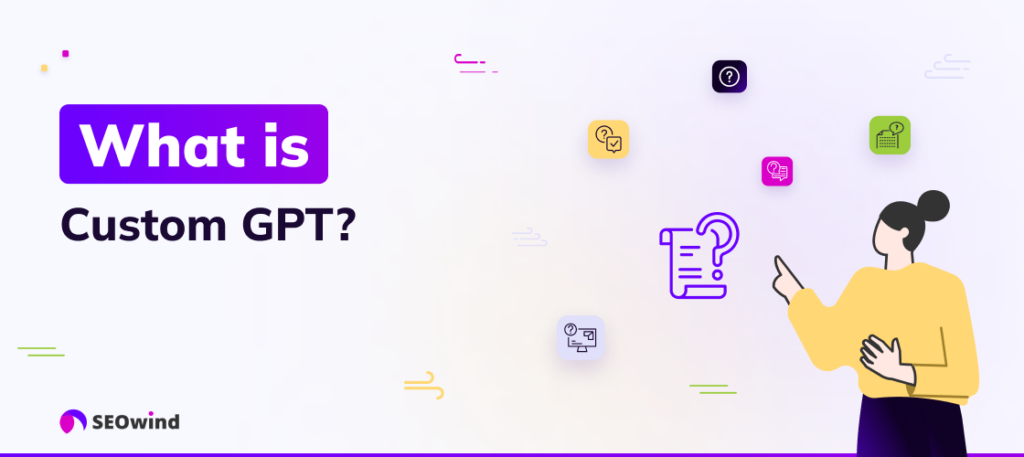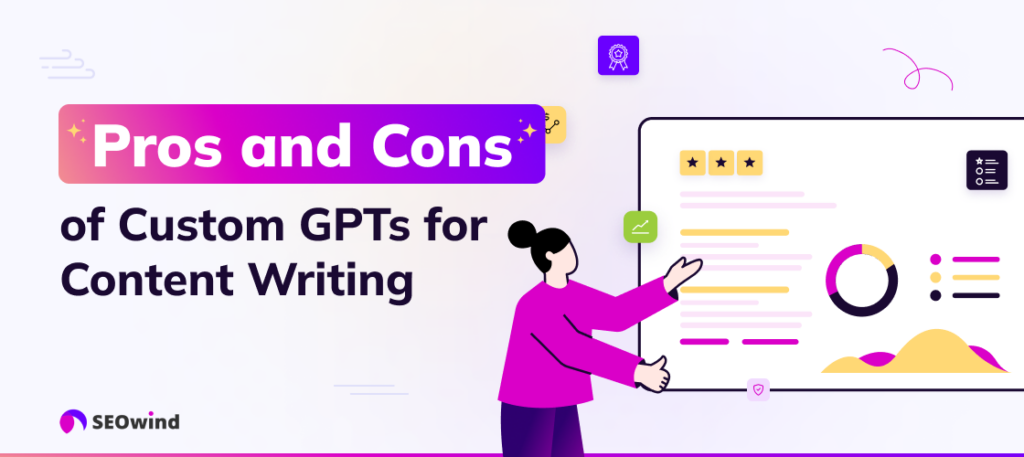A growing number of content creators are turning towards Custom Generative Pre-trained Transformers (GPTs) as innovative tools for content writing. As these bespoke AI models increasingly find their niche in customizing and streamlining content generation processes, it becomes essential for us to understand their capabilities. Understanding the pros and cons of Custom GPTs, alongside their optimal applications, equips us with the knowledge to leverage them effectively. This article offers a practical guide to employing Custom GPTs, ensuring that you’re well-prepared to use this AI tool to enhance the quality and efficiency of your content writing.
What is Custom GPT?

A Generative Pre-trained Transformer (GPT) is an artificial intelligence that understands and generates human-like text. It relies on a complex architecture known as the transformer, which allows the AI to weigh the importance of different words in a sentence, facilitating a better understanding of context.
It achieves this through extensive training on a diverse dataset, allowing it to learn patterns in language and context. This foundation enables it to complete text prompts, answer questions, and even create content that feels authentically human.
When it comes to GPT, customization is a step towards refining its capabilities to better align with specific tasks or industries. By customizing GPT, you create a more focused version of this powerful tool that adapts its vast linguistic abilities to serve specialized purposes such as legal analysis, creative storytelling, or technical writing. This customization process translates to a model that understands the general language and nuances of your specific domain or business.
Pros and Cons of Custom GPTs for Content Writing

Utilizing custom GPTs for content creation carries with it a unique set of advantages and disadvantages that should be carefully considered:
Pros of Custom GPTs for Content Writing
- Tailored Content: Custom GPTs can produce material that closely aligns with a company’s unique voice and expertise, leading to more engaging and authoritative content.
- Scalability: They enable the rapid production of content, which is especially beneficial for businesses looking to increase their digital footprint quickly.
- Consistency: GPTs can be trained to understand objectives and act upon them, incorporating vast data to enhance comprehension. Since the custom GPT adheres to specified parameters, it consistently reflects a brand’s tone and messaging, supporting brand identity.
Cons of Custome GPTs for Content Writing
- Not applicable for writing long-form articles and blog posts that rank – custom GPTs fail when dealing with a multi-step approach where the output of one stage serves as an input of the next one,
- Oversight: Custom GPTs still require human oversight to ensure content quality and avoid generating inaccurate or off-brand material.
- Training Time: Building a custom GPT involves an initial investment of time to provide suitable training materials and instructions.
- Complexity: The process might be challenging for those lacking technical expertise in AI and machine learning.
AI Content Creation with GPTs – Game-Changer or Flop?
As everybody talks about custom GPTs, we decided to go deeper into how they can be used for content writing, especially for writing SEO-optimized articles that drive traffic. Tom Winter, SEOwind CGO, hosted a webinar, going through GPTs capabilities and comparing it to SEOwind AI Content Writing Tool.
To learn more just watch the webinar below.
Custom GPTs use cases for Content Writing – what works
Quick Task Execution
The agility of Generative Pre-trained Transformers (GPTs) lies in their capacity to swiftly perform tasks predicated on a single input. When you put forward a prompt, these powerful language models can churn out responses with impressive speed and accuracy. This makes them immensely useful for various applications, from crafting emails to generating creative writing pieces.
- Single Prompt Wonders: GPTs can produce comprehensive content with just one prompt, making them excellent tools for generating ideas or expediting content creation.
- Brand Consistency: Companies can leverage GPTs to maintain a uniform tone and style across all their digital content, ensuring that every piece aligns with the brand’s voice, ethos, and messaging goals.
Application in Structured Tasks
When it comes to tasks that require categorization or a degree of organization within set parameters, GPTs shine. These AI models can organize information swiftly, discerning categories and arranging data points in an orderly. Their ability to understand the context and execute instructions makes them invaluable for sorting customer feedback or organizing product inventories.
Custom GPTs Limitations for Content Writing
Struggles with Multi-Step Processes
Where GPTs demonstrate a nuance in tackling simple, singular prompts, they often falter when navigating complex tasks involving multiple steps. These tasks typically require higher-order thinking and a series of interlinked actions, which can be challenging for a model that primarily responds to immediate, one-off inputs.
AI lacks sequential understanding. AI struggles to maintain coherence across tasks that must be performed in a specific sequence over time, a critical aspect of project management and long-term planning.
Difficulty with Exact Sciences
Where precision is non-negotiable and only one correct answer exists, such as in complex mathematical problems or coding, GPTs can stumble. Their generative nature is not best suited for tasks that don’t benefit from creativity or extrapolation but instead demand exactitude and definitive solutions.
When writing articles that bring traffic, you need to do content research. This is not an easy task as GPTs are not great with data scraping yet. For tasks like web scraping, where precise information extraction is key, GPTs may not be the best fit due to potential inaccuracies or incomplete data retrieval.
Complex Decision-Making Challenges
The most daunting obstacle GPTs face is understanding the intricacies of when to cease generating content and how to structure information for more complex decision-making effectively. They lack the nuanced judgment required to navigate sifting through vast amounts of data to identify what is most relevant for making strategic decisions or executing high-level analysis.
By understanding the strengths and limitations of GPTs, businesses and individuals can make informed decisions on how best to utilize these advanced tools, ensuring that they are tapped for tasks where they can provide the most benefit and avoiding their use in scenarios where they might fall short.
SEOwind vs. Custom GPTs for Content Writing
The digital content landscape is bustling with advanced tools to facilitate content creation. Among these, SEOwind emerges as a revolutionary platform that harmonizes artificial intelligence with intricately designed SEO strategies. Let’s delve into how SEOwind carves a niche, offering a competitive edge over custom Generative Pre-trained Transformers (GPTs) in content writing.
In-Depth Research and Analysis
SEOwind transcends the conventional approach by not merely responding to individual page prompts. It applies a more sophisticated method:
- Robust Analysis: It commences by meticulously examining the top results on Google for any given query, painting a comprehensive picture of what succeeds in the current digital landscape.
- Semantic Keyword Clustering: This platform stands out by clustering keywords based on their semantic relationships, which contributes to more nuanced and targeted content.
- Crafting Search-Intent-Driven Briefs: SEOwind can construct content briefs that align closely with search intent, ensuring the produced content resonates with users’ seeking.
These features ensure that the content is not just generated but sculpted with the nuances of online search behavior in mind.
A Collaborative Approach to Content
While custom GPTs are indeed powerful, SEOwind acknowledges the intricacies that require human insight, leading to a more collaborative model:
- Human-AI Synergy: By positioning human expertise as paramount, SEOwind empowers content creators to steer the AI, fine-tuning the outcome to match intended goals.
- Competitor Insight Integration: The tool evaluates competitor content, allowing creators to grasp and refine elements that might miss an AI’s analytic capabilities.
- Brand Voice Infusion: SEOwind stands out by effortlessly blending the unique brand voice and precise company details into the content, tailoring it to the organization’s identity.
This synergy between human judgment and AI efficiency is where SEOwind truly shines, providing a transformative tool for content creators.
Adapting To User Needs
SEOwind can cater to multiple projects simultaneously, which is ideal for agencies that manage content across various clients and domains. It also aligns with different languages, adjusting to cultural and linguistic nuances in content generation.
Explaining the necessary steps to build a custom ChatGPT
Login process and access to an OpenAI account
Access begins with a secured login into your OpenAI account. Custom GPT development is a rather advanced feature, so availability is currently restricted to certain account tiers, like ChatGPT Plus or Enterprise users.
Creating a new GPT from scratch
From your account, navigate to the ‘Create a GPT’ section. Here, you will provide a detailed description of the GPT’s intended role, enabling the builder to lay the foundation for your custom model, which you will then enhance through further interaction and instruction.
Guidelines for configuring and saving the custom GPT
In subsequent steps, you can refine the GPT’s persona, set up rules, and upload documents that encode your organizational wisdom. With all parameters adjusted, you save your configuration, clarifying how you’d like to share the newly crafted GPT.
Editing and Modifying Custom Chatbots
It’s crucial to iterate your GPT’s output, aligning it more closely with your expectations. Editing could involve enhancing instructions for clarity, adjusting tone, or revising knowledge sources for better-informed responses.
Techniques for improving the accuracy and relevance of chatbot interactions
Regularly assess the chatbot’s performance, seeking user feedback and monitoring its efficacy in varying contexts. Incorporate updates that tackle observed deficiencies, leading to more accurate and contextually relevant interactions.
Exploring options for sharing and implementing custom chatbots
Once your chatbot is meeting your standards, consider deployment options. This could mean integrating the bot into your website, sharing access with team members, or making the bot publicly accessible, depending on the intended scope of use.


